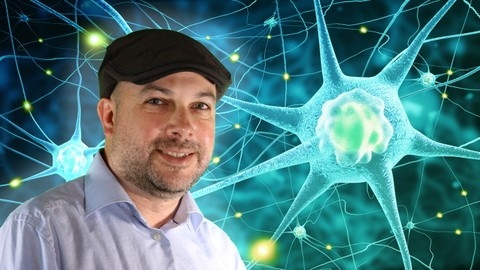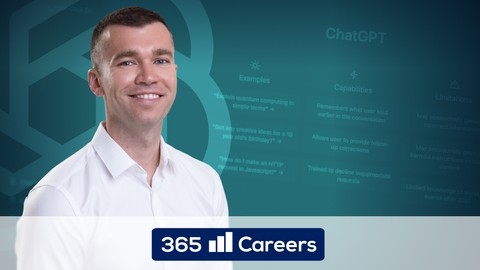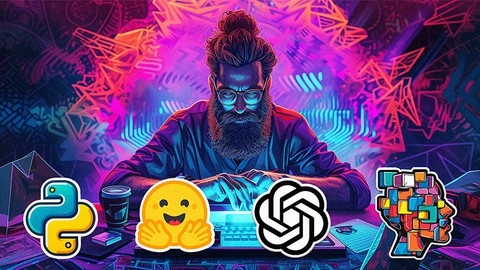How to use ChatGPT and Generative AI to help create content
This course is a comprehensive guide to using cutting-edge tools like ChatGPT, Midjourney, and Stable Diffusion to create stunning visuals and compelling content.
You’ll start by diving into the fundamentals of generative AI, including image generation with Midjourney, DALL-E, and Adobe’s Firefly.
Explore techniques for generating, editing, and manipulating images using prompts and AI models.
The course even covers advanced topics like understanding Generative Adversarial Networks (GANs) that power these tools.
You’ll also delve into the world of large language models (LLMs) and transformers that drive text generation.
Master prompt engineering skills to get the most out of ChatGPT, Gemini, and the OpenAI API.
Learn to generate articles, code, summaries, and more with incredible efficiency.
The course provides hands-on examples for everyday use cases like planning trips, writing emails, coding websites, and even pair programming with AI.
You’ll gain insights into the ethical considerations surrounding generative AI and best practices for responsible usage.
For developers, there’s a dedicated section on using the OpenAI API, fine-tuning GPT models, and building custom applications.
Explore the Completions API for tasks like translation and summarization, and the Chat Completion API for creating chatbots.
Throughout the course, you’ll encounter real-world case studies from companies like Coca-Cola and Buzzfeed, highlighting the practical applications of generative AI.
Stay ahead of the curve with updates on the latest advancements, including the highly anticipated Gemini model from Google.
Machine Learning, Data Science and Generative AI with Python
Starting with setting up a Python environment tailored for scientific computing across Windows, Mac, or Linux, this course ensures you’re well-prepared.
It includes a Python crash course covering syntax, data structures, and functions, making it accessible if you’re new or returning to Python.
The curriculum progresses to foundational statistics and probability, applying these concepts through Python for a practical learning experience.
You’ll explore predictive models, including linear and polynomial regression, and delve into machine learning with supervised and unsupervised learning, Bayesian methods, and K-Means clustering.
A significant focus is on neural networks and deep learning, where you’ll learn to implement models using Tensorflow and Keras, and understand convolutional and recurrent neural networks.
The course also introduces you to the cutting-edge field of generative AI, including Variational Auto-Encoders (VAE’s) and Generative Adversarial Networks (GAN’s), for synthesizing realistic images.
Practical activities are integrated throughout, allowing you to apply concepts in real-world scenarios, from spam classifiers to movie recommendation systems.
The course culminates in a final project on mammogram image classification, challenging you to apply your learning.
Additionally, you’ll gain insights into deploying models, conducting A/B tests, and the ethical considerations in deep learning.
With the latest on Generative AI, including GPT and ChatGPT, this course equips you with the skills to tackle current and future challenges in machine learning and data science.
ChatGPT Complete Guide: Learn Midjourney, ChatGPT 4 & More
This comprehensive program covers a wide range of topics, from mastering ChatGPT and its advanced features to creating stunning digital art with Midjourney.
You’ll also explore other cutting-edge AI tools like DALL-E, Adobe Firefly, and Google’s AI Music Maker.
The course starts by diving deep into ChatGPT, teaching you how to effectively create prompts, use prompt engineering techniques, and leverage custom GPTs.
You’ll learn about ChatGPT’s inner workings, how it was trained, and how it generates outputs.
The course also covers ChatGPT’s mobile app, plugins, and integrations with tools like Google Sheets and Zapier.
Moving on, you’ll immerse yourself in the world of Midjourney, a powerful AI tool for generating digital art.
From setting up your account to mastering advanced prompting techniques, you’ll learn how to create breathtaking images for personal and professional projects.
The course covers aspect ratios, upscaling, remixing, and even blending multiple images together.
You’ll also explore other AI tools like DALL-E 2 for image creation, Adobe Firefly for generative art and text effects, and Photoshop AI for remixing and reinventing your images.
The course delves into AI voice tools, allowing you to fix audio, generate text-to-voice, and even clone your voice.
Additionally, you’ll discover how to leverage AI for various purposes, such as content creation, copywriting, SEO, video scripts, and even coding.
The course covers AI integrations with tools like Google Sheets, Zapier, and Notion, enabling you to automate workflows and optimize productivity.
Throughout the course, you’ll learn from expert guest instructors and interviews, gaining insights into the present and future of AI across multiple industries.
Intro to ChatGPT and Generative AI
You’ll begin by understanding the hype surrounding ChatGPT and what it truly is (and isn’t).
The course delves into the underlying technologies, such as AI, natural language processing (NLP), and large language models (LLMs), providing you with a solid foundation.
Prompt engineering is a crucial aspect covered in-depth.
You’ll learn how to sign up for ChatGPT, create your first prompt, and master the art of asking better questions.
Practical examples and techniques for effective prompting will empower you to harness ChatGPT’s full potential, enhancing your critical thinking skills through multi-perspective responses.
It equips you with valuable mechanics and tools for working with ChatGPT, including renaming, sharing, and deleting conversations, adjusting settings, and creating instructions for future interactions.
You’ll even explore ChatGPT’s team plan capabilities.
Integrating external resources is a game-changer.
Discover how to leverage ChatGPT’s reading comprehension abilities, split and merge PDFs, generate training data, and utilize it as an Excel tutor and work assistant.
Additionally, you’ll learn about AI image comprehension, generation, and editing techniques.
As you progress, you’ll gain insights into practical applications, ethical considerations, and the future of AI.
Connect to the OpenAI API, explore the ethics of AI and the balance between progress and principles, and understand the concept of AI hallucination.
Master Generative AI: Automate Content Effortlessly with AI
You’ll start by getting an overview of the course outline and learning how to watch the lectures at your preferred pace.
Additionally, you’ll gain access to the course’s Discord channel for updates and a free AI newsletter.
The course dives deep into AI text generation with tools like ChatGPT, Google’s Bard, Bing GPT4, Poe, and Lambda.
You’ll learn prompt engineering techniques and explore ChatGPT’s capabilities, including code interpretation, web browsing, and knowledge base chatbot creation.
The course also covers AI image generation using Midjourney, DALL-E, Adobe Firefly, and open-source alternatives, teaching you how to create stunning visuals with prompts.
Moving on, you’ll automate video generation with tools like Meta’s MAKE-A-VIDEO, GEN-1, and Google’s IMAGEN.
You’ll even learn to generate real human videos and create video avatars of yourself.
The course also covers AI audio generation with OpenAI’s Whisper and Google’s MusicLM, allowing you to generate audio from text.
Autonomous AI is another exciting topic, where you’ll learn about AutoGPT, generative agents like AgentGPT and BabyAGI, and Devin, an AI software engineer.
Additionally, you’ll explore AI work automation with Google Workspace AI updates.
For developers, the course covers AI code generation with GPT-Engineer and low-code image generation using Stable Diffusion, DALL-E 2, and Google’s IMAGEN.
You’ll also learn the basics of generative AI, its history, and future expectations.
Beyond the core content, the course offers reviews and walkthroughs of fun AI tools, such as Notion AI for documentation, Text to 3D generation with Shap-E, and Control-a-video.
You’ll even get insights into the latest developments like Llama 2 vs GPT-4 and tips on staying up-to-date with AI in 2024.
Generative AI, from GANs to CLIP, with Python and Pytorch
You’ll begin by understanding the core concepts behind the generative AI revolution, including latent spaces, representation learning, and the benefits of these architectures.
The course then dives into coding a basic GAN from scratch, helping you grasp fundamental principles like the generator-discriminator battle and cross-entropy calculations.
But it doesn’t stop there.
You’ll level up by coding an advanced GAN capable of generating realistic human faces, exploring techniques like the Wasserstein loss, gradient penalty, and real-time training statistics tracking.
The real excitement begins when you combine the CLIP model (which connects text and images) with a generative transformer to create images from text prompts.
You’ll even learn to interpolate between points in the latent space for mesmerizing morphing effects.
Additionally, the course covers selectively editing parts of images using segmentation models and the Stable Diffusion generative model, allowing you to replace or modify specific elements like people’s clothing.
To top it off, you’ll engage in a guided visualization experience that exercises your mind’s generative capabilities, drawing parallels between biological and artificial neurons, their learning processes, and the pursuit of artificial general intelligence (AGI).
The instructor’s engaging style and real-world examples make the journey both informative and enjoyable.
ChatGPT Masters: Generative AI, Prompt Engineering, Chat GPT
The course provides a comprehensive introduction to ChatGPT, covering its capabilities, use cases, and practical applications across various domains.
One of the standout features of this course is its well-structured curriculum.
It starts with a solid foundation, explaining the basics of ChatGPT and gradually progresses to more advanced topics like prompt engineering techniques, creative applications, and real-world use cases.
The instructors do an excellent job of breaking down complex concepts into easily understandable segments, making the course accessible to learners of all levels.
The course excels in its practical approach, with numerous hands-on examples and demonstrations.
The instructors walk you through various scenarios, showcasing how to craft effective prompts for tasks such as content creation, research, social media management, and even coding.
This interactive learning experience ensures that you not only understand the theoretical aspects but also develop the skills to apply prompt engineering in your own projects.
One of the highlights of the course is the section dedicated to advanced prompt engineering techniques.
Here, you’ll learn strategies for fine-tuning prompts, incorporating context, and optimizing outputs for specific use cases.
The instructors provide valuable insights into prompt engineering best practices, enabling you to unlock the full potential of ChatGPT and other generative AI tools.
In addition to ChatGPT, the course also covers other AI tools like Google Bard and Midjourney, expanding your knowledge and allowing you to explore different AI-powered solutions.
The instructors seamlessly integrate these tools into the curriculum, demonstrating how they can complement and enhance your prompt engineering skills.
The course content is regularly updated to reflect the latest advancements in the field of generative AI, ensuring that you stay ahead of the curve.
The instructors also encourage active participation and feedback, fostering a collaborative learning environment where students can share their experiences and learn from one another.
LLMs Mastery: Complete Guide to Transformers & Generative AI
You’ll start by gaining an overview of NLP’s evolution, from rule-based systems to statistical models, machine learning, and the current embeddings era.
This historical context will help you appreciate the significance of transformers and LLMs.
The course then dives into the core concepts of transformers, such as encoders, decoders, and the attention mechanism.
You’ll also learn about pre-training, fine-tuning, tokenization, and embeddings – essential techniques for working with these powerful models.
You’ll explore popular transformer models like BERT, GPT, and T5, understanding their strengths and weaknesses to choose the best model for your task.
The practical sections will teach you the building blocks and hidden gems of using transformers.
From tokenizers and word embeddings to masked language modeling (MLM) and semantic search indexing, you’ll gain hands-on experience with the tools and techniques that power modern NLP applications.
Finally, you’ll master real-world scenarios by applying transformers and LLMs to tasks like extractive question answering with BERT, instruction following with GPT, and writing product reviews with T5.
These practical examples will solidify your understanding and prepare you for tackling your own NLP challenges.
Generative AI - Risk and Cyber Security Masterclass 2024
The course starts with an introduction to generative AI and large language models (LLMs), explaining what they are and how they work.
This lays the foundation for understanding the risks involved.
Next, it dives deep into the various risks associated with generative AI.
You’ll learn about data privacy and confidentiality concerns, potential breaches by GenAI providers, and the evolving threat landscape with new types of actors.
It covers critical issues like data leakage, prompt injections (both direct and indirect), inadequate sandboxing, hallucinations, server-side request forgery (SSRF) attacks, DDoS attacks, data poisoning, model bias, and even copyright violations.
It also provides guidance on how to secure generative AI systems.
You’ll learn about threat modeling specific to GenAI security and get an AI governance checklist for LLMs.
This practical knowledge will help you mitigate the risks and ensure responsible use of these powerful technologies.









